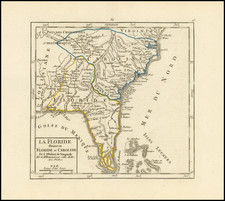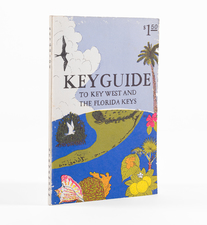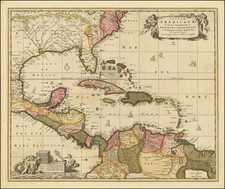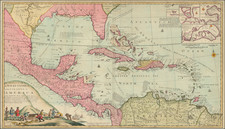Survey of Eastern Steamboat Routes from the St. Johns River, 1882
Scarce map of central Florida, published by the US Government to illustrate the report of Q.A. Gilmore on the prospect for a ship Canal across the Florida peninsula.
The map was issued to illustrate the continuing interest in creating a watercourse across Florida, which would allow inland navigation between the two coasts, a continuation of interest in creating such a passage which pre-dated the American Revolution, dating back to the Florida Canal Project
The Florida Canal Project
The Florida Canal project was proposed initially in 1763, when the British took over Florida, and again in 1821, when the United States retook possession. Exploratory missions were conducted by the British who also believed that the waterway existed.
American proposals, beginning with Jefferson's administration, favored construction of a canal. Jefferson was concerned with Florida's proximity to Cuba and Cuban influence on navigation in the Gulf of Mexico. A canal across Florida would destroy Cuba's power over trade around the tip of the peninsula. Jefferson's Secretary of the Treasury, Albert Gallatin, was interested in waterway development, as was George Washington earlier.
In 1830 the Southern Review reported: "Mr. Gallatin suggested the inquiry into the feasibility of uniting the St. Mary's and the Mississippi, and on the temporary occupation of Florida, by the American troops, in 1818, Mr. Calhoun, the Secretary of War, seized the occasion of directing some partial examinations near the head waters of the St. Mary's and the Suwannee, with the view to inland communication between the Atlantic and the Gulf."
It was not until 1824 that the project was seriously studied in earnest. On December 24, 1824, the Florida Legislature approved a proposal to seek assistance from Congress to pursue the idea. Richard Keith Call, Florida territorial delegate to Congress, submitted a plan to cut a water across Florida to the House Committee on Roads and Canals in February 1825. After the formation of a 3 man committee, the state submitted a formal proposal in December 1825.
In January 1826, Congress appropriated $20,000 for a canal survey. General Simon Bernard, who previously served as Napoleon's chief Engineer, to oversee the survey. The survey examined 2 routes, one from the St. Johns River to Vassasousa Bay and the other from the St. Mary's River to the Apalachiola River. Major Paul H. Perrault joined General Bernard in conducting the surveys. The report concluded that a ship canal was not possible, but that a six foot deep steamship canal was possible. The report final report was submitted by to the President John Quincy Adams, was signed by General Bernard and Captain William Tell Poussin and included a general map of the area and several possible canal routes.
Congress appropriated an additional $10,400 to complete the canal survey under the direction of Major Poussin. Poussin remained in charge until the Summer of 1831, when he returned to France. The final survey was submitted without a cost estimate and thereafter, the project was abandoned.
Three more surveys were conducted in the 19th Century. In August 1852, Congress authorized the Corps of Topographical Engineers to survey two different routes from the St. Johns River to Tampa Bay led by Lieutenant I.M. Smith. In December 1872, a Congressional committee established the Windom Select Committee to study and recommend a passage across the state. In 1875 and 1878, two additional routes were considered. These proposals were led by Lieutenant Colonel Q.A. Gilmore and became part of the so-called "Gilmore Report," which including a proposal for a barge canal and a more expensive ship canal, with locks.
In 1878, a private venture led by Robert Gamble evaluated the prospects of a canal, as did the Florida State Canal Commission in the 1920s. In the 1920s, the US Government took up the project again, with President Harding signing a bill in 1927 to commence a study, which would set in motion the final attempt to build the canal. Efforts to create the canal continued into the 1930s, when the Army Corps of Engineers surveyed and commenced construction of a canal, which was worked on until the early 1970s, when Richard Nixon finally ended the project in 1971, at a time when the canal was only about 1/4 completed.











![(Colonial East Florida) [Letter From Thomas Bond in St. Augustine, East Florida, September 14, 1770 to his Father, John Bond, Merchant of Fells Point, Baltimore County, Maryland]](https://storage.googleapis.com/raremaps/img/small/86621.jpg)


![[Rare First State] Novissima Tabula Regionis Ludovicianae Gallice dictae la Louisiane . . .](https://storage.googleapis.com/raremaps/img/small/72622.jpg)